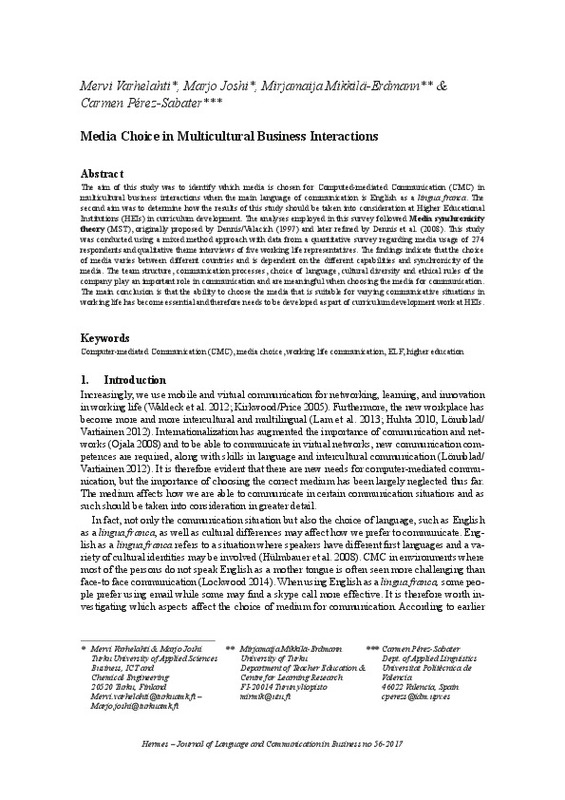JavaScript is disabled for your browser. Some features of this site may not work without it.
Buscar en RiuNet
Listar
Mi cuenta
Estadísticas
Ayuda RiuNet
Admin. UPV
Media Choice in Multicultural Business Interactions
Mostrar el registro sencillo del ítem
Ficheros en el ítem
| dc.contributor.author | Varhelahti, Mervi
|
es_ES |
| dc.contributor.author | Joshi, Marjo
|
es_ES |
| dc.contributor.author | Mikkilä-Erdmann, M.
|
es_ES |
| dc.contributor.author | Pérez-Sabater, Carmen
|
es_ES |
| dc.date.accessioned | 2020-02-06T21:01:53Z | |
| dc.date.available | 2020-02-06T21:01:53Z | |
| dc.date.issued | 2017 | es_ES |
| dc.identifier.issn | 0904-1699 | es_ES |
| dc.identifier.uri | http://hdl.handle.net/10251/136403 | |
| dc.description.abstract | [EN] The aim of this study was to identify which media is chosen for Computed-mediated Communication (CMC) in multicultural business interactions when the main language of communication is English as a lingua franca. The second aim was to determine how the results of this study should be taken into consideration at Higher Educational Institutions (HEIs) in curriculum development. The analyses employed in this survey followed Media synchronicity theory (MST), originally proposed by Dennis/Valacich (1997) and later refined by Dennis et al. (2008). This study was conducted using a mixed method approach with data from a quantitative survey regarding media usage of 274 respondents and qualitative theme interviews of five working life representatives. The findings indicate that the choice of media varies between different countries and is dependent on the different capabilities and synchronicity of the media. The team structure, communication processes, choice of language, cultural diversity and ethical rules of the company play an important role in communication and are meaningful when choosing the media for communication. The main conclusion is that the ability to choose the media that is suitable for varying communicative situations in working life has become essential and therefore needs to be developed as part of curriculum development work at HEIs. | es_ES |
| dc.description.sponsorship | This work was supported by the Erasmus+ Project CoMoViWo, Communication in Mobile and Virtual Work under Grant KA 2014-1-F101-KA203-00851. | es_ES |
| dc.language | Inglés | es_ES |
| dc.publisher | Aarhus Universitet. School of Business and Social Sciences | es_ES |
| dc.relation.ispartof | Hermes | es_ES |
| dc.rights | Reconocimiento (by) | es_ES |
| dc.subject | Computer-mediated Communication (CMC) | es_ES |
| dc.subject | Media choice | es_ES |
| dc.subject | Working life communication | es_ES |
| dc.subject | ELF | es_ES |
| dc.subject | Higher education | es_ES |
| dc.subject.classification | FILOLOGIA INGLESA | es_ES |
| dc.title | Media Choice in Multicultural Business Interactions | es_ES |
| dc.type | Artículo | es_ES |
| dc.identifier.doi | 10.7146/hjlcb.v0i56.97230 | es_ES |
| dc.relation.projectID | info:eu-repo/grantAgreement/EC/Erasmus+/2014-1-FI01-KA203-000851/EU/Communication in Mobile and Virtual Work/ | es_ES |
| dc.rights.accessRights | Abierto | es_ES |
| dc.contributor.affiliation | Universitat Politècnica de València. Departamento de Lingüística Aplicada - Departament de Lingüística Aplicada | es_ES |
| dc.description.bibliographicCitation | Varhelahti, M.; Joshi, M.; Mikkilä-Erdmann, M.; Pérez-Sabater, C. (2017). Media Choice in Multicultural Business Interactions. Hermes. (56):163-180. https://doi.org/10.7146/hjlcb.v0i56.97230 | es_ES |
| dc.description.accrualMethod | S | es_ES |
| dc.relation.publisherversion | http://dx.doi.org/10.7146/hjlcb.v0i56.97230 | es_ES |
| dc.description.upvformatpinicio | 163 | es_ES |
| dc.description.upvformatpfin | 180 | es_ES |
| dc.type.version | info:eu-repo/semantics/publishedVersion | es_ES |
| dc.description.issue | 56 | es_ES |
| dc.relation.pasarela | S\352683 | es_ES |
| dc.contributor.funder | European Commission | es_ES |








